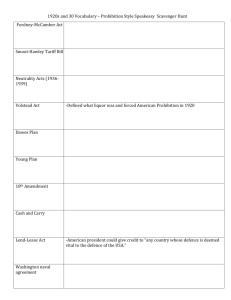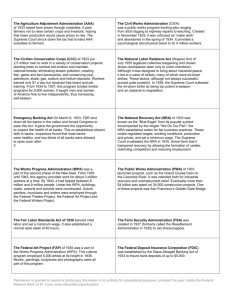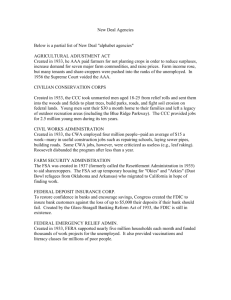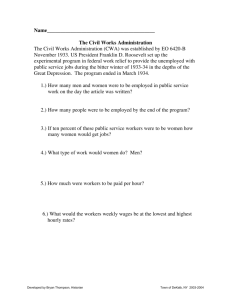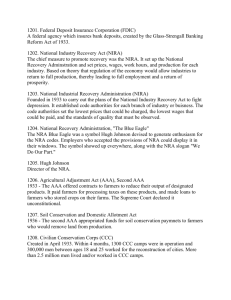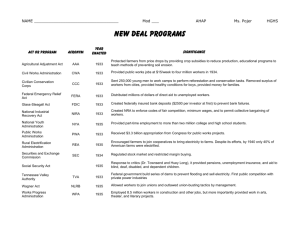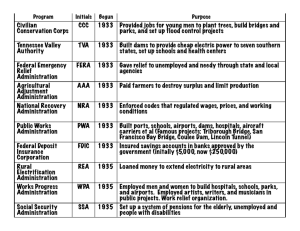PowerPoint - Federal Reserve Bank of St. Louis
advertisement
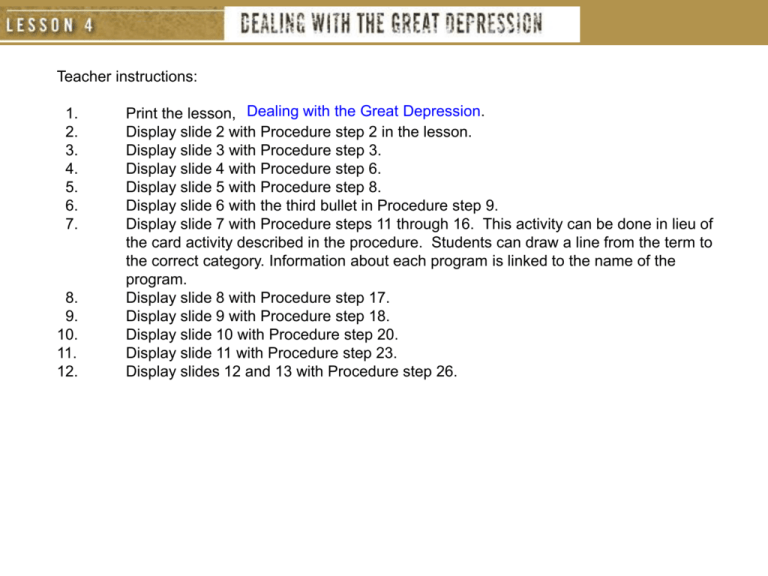
Teacher instructions: 1. 2. 3. 4. 5. 6. 7. 8. 9. 10. 11. 12. Print the lesson, Dealing with the Great Depression. Display slide 2 with Procedure step 2 in the lesson. Display slide 3 with Procedure step 3. Display slide 4 with Procedure step 6. Display slide 5 with Procedure step 8. Display slide 6 with the third bullet in Procedure step 9. Display slide 7 with Procedure steps 11 through 16. This activity can be done in lieu of the card activity described in the procedure. Students can draw a line from the term to the correct category. Information about each program is linked to the name of the program. Display slide 8 with Procedure step 17. Display slide 9 with Procedure step 18. Display slide 10 with Procedure step 20. Display slide 11 with Procedure step 23. Display slides 12 and 13 with Procedure step 26. Money supply (stock) is the amount of currency, coins and checkable deposits people have. Fiscal policies are the spending and taxing policies used by the federal government to influence the economy. Federal Emergency Relief Administration (FERA) National Youth Administration (NYA) Civilian Conservation Corps (CCC) Tennessee Valley Authority (TVA) Public Works Administration (PWA) Social Security Act of 1935 RELIEF Federal Art Project (FAP) R E C O V E R Y Revenue Act of 1935 (Wealth Tax Act) Federal Theatre Project Civil Works Administration (CWA) Federal Housing Administration (FHA) Federal Writers Project (FWP) National Labor Relations Act (Wagner Act) Federal Deposit Insurance Corporation (FDIC) REFORM Securities and Exchange Commission (SEC) National Recovery Act (NRA) Rural Electrification Administration (REA) Emergency Banking Act COMBINATION Agriculture Adjustment Administration (AAA) Fair Labor Standards Act Works Project Administration (WPA) A budget deficit exists when federal government expenditures exceed the revenue collected by the government in a year. The national debt is the accumulation of deficits. Type of Program Unemploy- Government ment Rate Spending GDP Confidence Role of Level Government Relief increase decrease mixed increase decrease mixed increase decrease mixed increase decrease mixed increase decrease mixed Reform increase decrease mixed increase decrease mixed increase decrease mixed increase decrease mixed increase decrease mixed Recovery/ increase Combination decrease increase decrease mixed increase decrease mixed increase decrease mixed increase decrease mixed mixed The Agriculture Adjustment Administration (AAA) of 1933 raised farm prices through subsidies. It paid farmers not to raise certain crops and livestock, hoping that lower production would cause prices to rise. The Supreme Court struck down the tax that funded AAA subsidies to farmers. The Civil Works Administration (CWA) was a public works program funding jobs ranging from ditch digging to highway repairs to reaching. Created in November 1933, it was criticized as "make work" and abandoned in the spring of 1934. It provided a psychological and physical boost to its 4 million workers. Back The Civilian Conservation Corps (CCC) of 1933 put 2.5 million men to work in a variety of conservation projects: planting trees to combat soil erosion and maintain national forests; eliminating stream pollution; creating fish, game and bird sanctuaries; and conserving coal, petroleum, shale, gas, sodium ad helium deposits. Workers earned only $1 a day but received free board and job training. From 1934 to 1937, this program funded similar programs for 8,500 women. It taught men and women of America how to live independently, this increasing self-esteem. Back Emergency Banking Act On March 6, 1933, FDR shut down all the banks in the national and forced Congress to pass this Act. It gave the government the opportunity to inspect the health of all banks. This re-established citizens' faith in banks. Inspectors found that most banks were healthy, and two-thirds of all banks were allowed to open soon after. Back The Fair Labor Standards Act of 1938 banned child labor and set a minimum wage. It also established a normal work week of 40 hours. Back The Farm Security Administration (FSA) was created in 1937 (formerly called the Resettlement Administration in 1935) to aid sharecroppers. Back The Federal Art Project (FAP) of 1935 was a part of the Works Progress Administration (WPA). This cultural program employed 5,300 artists at its height in 1936. Murals, paintings, sculptures and photography were all part of this program. Back The Federal Deposit Insurance Corporation (FDIC) was established by the Glass-Steagall Banking Act of 1933 to insure bank deposits of up to $5,000. Back The Federal Emergency Relief Administration (FERA) of 1933 put money into public works programs, which were governmentfunded projects to build public facilities and create jobs. Back The Federal Housing Administration (FHA) of 1934 worked to improve housing standards and conditions and to insure mortgages. Back The Federal Music Project (FMP) of 1935 was a part of the Works Progress Administration (WPA). This cultural program employed about 16,000 musicians at its peak. Back The Federal Theatre Project (FTP) of 1935 was a part of the Works Progress Administration (WPA) and employed 12,700 theatre workers at its peak. The Federal Theatre units presented more than 1,000 performances each month before nearly 1 million people. There were 1,200 pays produced in the four years of the project. Back The Federal Writers Project (FWP) of 1935 was a part of the Works Progress Administration (WPA). This cultural program employed about 6,686 writers at its peak in 1936. It produced 3.5 million copies of 800 titles by 1941. Back The National Recovery Act (NRA) of 1933 was known as the "Blue Eagle" from its popular symbol. Accompanied by the slogan "We Do Our Part," the NRA established codes for fair business practices. These codes regulated wages, working conditions, production and prices and set a minimum wage. The Supreme Court invalidated the NRA in 1935. Some think that it hampered recovery by allowing the formation of cartels, restricting competition and reducing employment. Back The National Labor Relations Act (Wagner Act) of July 1935 legalized collective bargaining and closed shops (workplaces open only to union members). Although it was designed to bring about industrial peace, it led to a wave of strikes, many of which were sit-down strikes. These tactics although not always successful, proved quite powerful. In 1939, the Supreme Court outlawed the sit-down strike as being too potent a weapon and an obstacle to negotiation. Back National Youth Administration (NYA) created under the Emergency Relief Act of 1935, provided more than 4.5 million jobs for young people. It gave part-time employment to students, established training programs and provided aid to unemployed youth. Back The Public Works Administration (PWA) of 1933 launched projects, such as the Grand Coulee Dam on the Columbia River. It was intended both for industrial recovery and unemployment relief. Eventually more than $4 billion was spent on 34,000 construction projects. One of these projects was San Francisco's Golden Gate Bridge. Back The Rural Electrification Administration (REA) of 1935 offered loans to electric companies and farm cooperatives for building power plants and extending power lines. Back The Securities and Exchange Commission (SEC) of 1934 required full disclosure of information on stocks being sold. The SEC regulated the stock market. Congress also gave the Federal Reserve Board the power to regulate the purchase of stock on margin. Back The Social Security Act of 1935 established the administration of a national pension fund for the aged and unemployed, as well as public assistance for dependent mothers, children and disabled people. It was financed by a payroll tax based on employer and employee contributions. Back The Tennessee Valley Authority (TVA) was created for the economic development of the Tennessee River watershed. Many jobs were created as a result of 20 dams built to control flooding, generate electricity and increase agricultural production. Back The Works Progress Administration (WPA) was a part of the second phase of the New Deal. From 1935 until 1943, this agency provided work for about 3 million workers at a time. By 1943, it had helped between 8 million and 9 million people. Under the WPA, buildings, roads, airports and schools were constructed. Actors, painters, musicians and writers were employed through the Federal Theatre Project, the Federal Art Project and the Federal Writers Project. Back The Revenue Act of 1935 (Wealth Tax Act) raised the tax rate on individual incomes that exceeded $50,000 and also increased rates on the income and profits of corporations. Back The Civil Works Administration (CWA) was a public program funding jobs ranging from ditch digging to highway repairs to teaching. Created in November 1933, it was criticized as "make work" and abandoned in the spring of 1934. It provided a psychological and physical boost to its 4 million workers. Back
